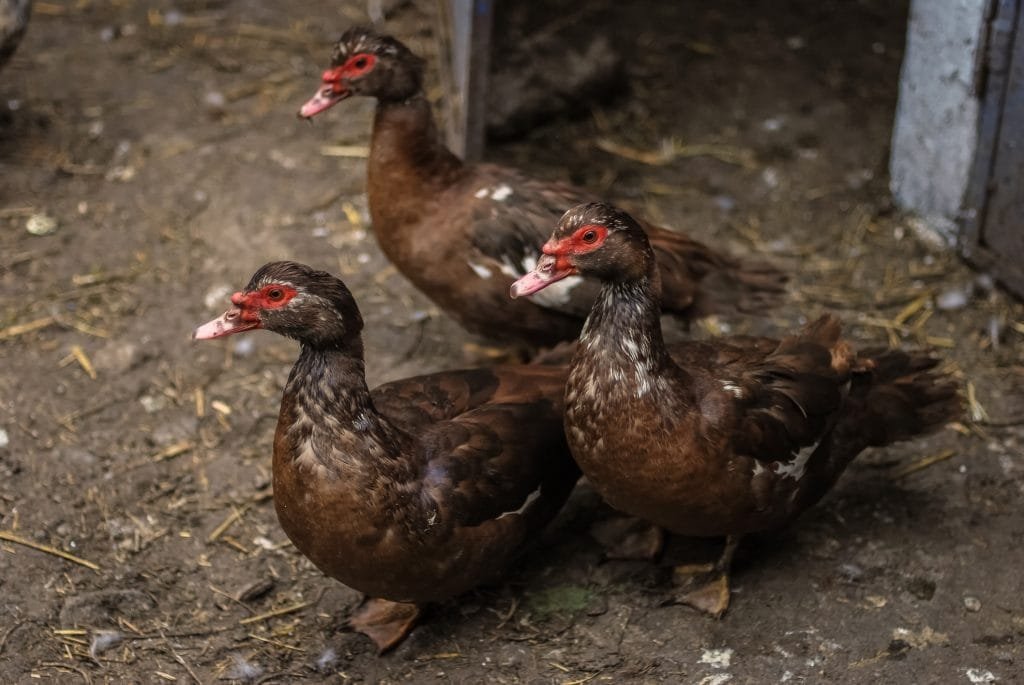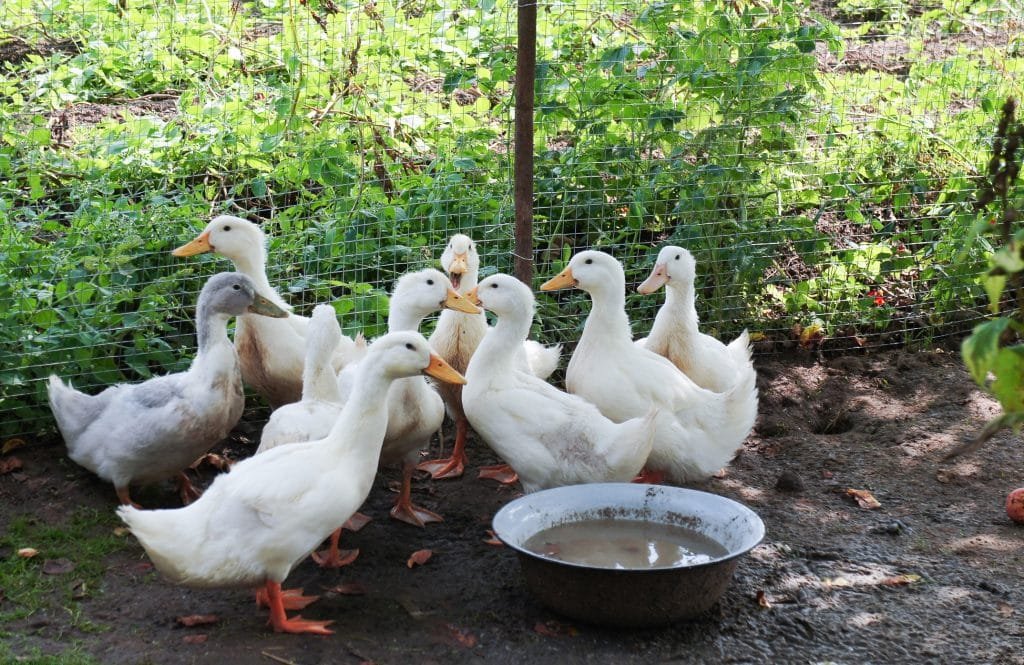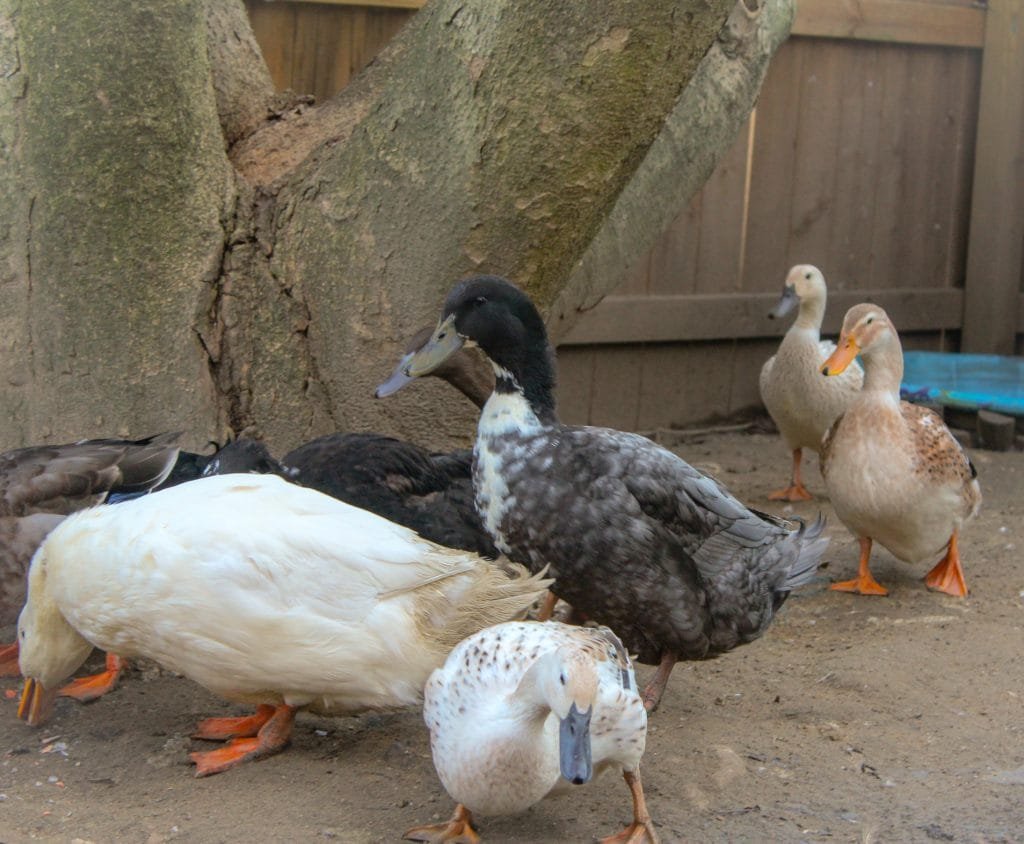This post contains affiliate links.
Ducks are becoming very popular with homesteads and backyard farms. Raising ducks has many benefits and are a great source of meat, feathers and eggs. When getting started with ducks you may be wondering if there is a minimum or even maximum number of ducks you should get.
Ducks are very social animals, you should keep a minimum of 3 ducks, while 5 to 6 is the optimal number for household uses like eggs. The number of ducks you should get will depend on the land available, the reason you want to raise ducks, and the desired size of the operation.
Although many people raise chickens on their smallholdings/homesteads, a popular alternative is keeping ducks. The benefits of this poultry are far-reaching, but you need to determine the ideal amount for your needs. Learn how the species and purpose of farming play a role in the number of ducks you should get.

How Many Ducks Are Enough
Three ducks are the minimum number of ducks you should get. Ducks are social animals and for this reason, ducks should never be kept alone. The benefit of keeping a minimum of 3 ducks is that if one were to die, the remaining ducks will not be alone. Ducks that are kept on their own tend to pine/become depressed, which results in their untimely deaths or a loss in performance (breeding, eggs, etc.).
Ducks generally do better in group sizes of 5 or 6, because of this social aspect. A larger group result in ducks feeling safer in greater numbers, as they are less vulnerable to predation, and therefore happier to feed, breed, and grow (reduced stress).
A group of six ducks usually consists of five females and one male. This is the ideal ratio to prevent fighting between males, and because a group of ducks this size will produce a greater number of eggs. The eggs could be eaten, or hatched and raised to produce meat and feather birds, or sold to other duck farmers.
When keeping ducks, and trying to determine the total number you want to keep, two variables are critical:
- What is the purpose of keeping the ducks? Do I want them as pets? To farm with? What type of farming do I want to do?
- How much space is available to keep the ducks in? Spacial restrictions are the most important, because without the necessary space, you will be limited in the number of ducks you could keep.
Other factors, like, the species of ducks, the size of the operation (current and future growth), and what local laws and regulations dictate, are also important factors to consider when keeping ducks. These factors will place a maximum limit on what you may keep.
For example, some states may have laws against keeping livestock in your backyard, while others may allow you to keep small flocks of ducks for personal use. If you want to start a commercial duck farm, you would need to find a space in an area that allows you to keep 20 or more ducks.
What Is The Purpose Of Keeping Ducks
When keeping livestock, it is usually to meet a specific need. Keeping livestock for the sake of keeping it is usually too expensive to be worthwhile.
The purpose that the ducks being raised should serve is important when determining how many ducks need to be kept. Ducks provide a wide range of benefits, both dead and alive, they are a worthwhile addition to any farm or smallholding.
Some of the primary reasons for keeping ducks from a farming perspective include:
Raising Ducks For Meat
Duck meat is a more commonly known, less commonly experienced reason for raising them as livestock.
On average, duck meat production requires slaughtering ducks at a younger age (minimum of six weeks old, but usually at between eight and twelve weeks). Learn more about when ducks should be slaughtered in my article, What Age Are Ducks Slaughtered For Meat?
Often, what farmers who raise ducks for meat do is purchase ducklings from a reputable hatchery. They then raise the ducks for around eight weeks, after which they slaughter them.
Sometimes ducklings can a lot of noise. If you find they are quacking a lot check out my article, Why Won’t My Duckling Stop Quacking, to help solve the problem.
The amount of ducks you should keep for meat depends entirely on the number of ducks you need to eat/sell as meat and your available resources (capacity). Typically one duck will feed a family of four one meal.
Some people take twenty hatchlings and, after raising them, slaughter most while keeping a few for eggs. Others may take only the number they need (four or five) and then get the next batch after a few weeks.
If you want to keep adult ducks to breed, five or six ducks should be more than enough (one drake and four or five hens) to supply a family’s needs. This number will produce ample eggs while still producing chicks that you can raise and slaughter for meat.

Raising Ducks For Feathers
Most often, you would not raise ducks solely for their plumage. Instead, you would raise ducks for a combination of either meat and feathers or meat, eggs, and feathers.
Of the entire duck, only around 20% of the feathers are considered “down,” which are the desirable type of feather for pillows. It will take roughly 24 ducks to make a down feather pillow. If you are slaughtering ducks for meat, you’ll need at least this many to make collecting their feathers worthwhile.
The advantage of selling the feathers is another value-added benefit to raising ducks. These value-added benefits (including manure) bring down the overall cost of raising ducks because their value increases, i.e., you’re putting more money back into the operation.
Raising Ducks For Eggs
Raising ducks for their eggs has many comparisons with raising chickens for eggs. On average, female ducks produce between 200 and 340 eggs annually. If you are wondering how hard is it to keep ducks for eggs check out my article, How Hard Is It To Raise Ducks For Eggs?
Ducks are considered superior egg layers to chickens as they produce year-round (even during the colder winter months without additional lighting). They begin laying eggs at around five/six months of age and lay for several years (sometimes up to six).
When keeping ducks for their eggs in a backyard/smallholding context for self-sufficiency, you should aim for at least three ducks (hens), but, depending on your space, the ideal number is five or six. The delineating factor is how many eggs you want/need in a week/month.
For example, if you need around two dozen eggs per week (24), that equals 1248 eggs in a year (24x 52 weeks). Most ducks produce between 200 and 350 eggs annually. So for a species that produces around 200 eggs, you would need six ducks to meet your need.
If you plan on keeping males (drakes) with the females, then aim for a ratio of one male to four/five females. These ratios are for free-ranging flocks that are allowed to mingle. Ducks are social animals and benefit from interactions and from a free-range lifestyle (plus, you’ll also reap the rewards).
Drakes are not necessary for females to lay eggs, but they are critical to growing your flock if you want fertilized eggs.
Raising Ducks As A Breeder
Under this context, your focus is not on growing ducks to maturity yourself but rather breeding ducks and selling the chicks off at a certain age. In these situations, the more juveniles you can produce, the better, as you will have more “stock” when selling.
Ducks will raise on average two clutches of between eight and sixteen chicks annually, and certain breeds are more successful in sitting on and hatching babies than others (Muscovy’s are a great allrounder, and they sit well on their eggs, while Pekin’s are great for eggs, meat, and feathers, but make horrible mothers, so an incubator is required).
The number of ducks, in this case, should be at least 6, 5 hens, and 1 drake. If you have fewer hens the drake may “bother” the females too much. Also, the available land will greatly affect how many ducks you can have.
Other Reasons For Keeping Ducks
Concerning those who want to keep ducks, but are not interested in eating them, their eggs, or using their feathers, some other reasons for keeping ducks include:
Keeping Ducks As Pets
If you have children (or a soft spot for “cute animals”), then the thought of keeping a duck as a pet probably crossed your mind. Although you’ll not be breeding these birds for meat, the advantage of your “pets” is that they will still lay eggs (provided they are female), which you could still eat depending on your viewpoint.
Ducks do, however, make for relatively good pets, especially larger breeds that are less prone to predators. They are still gregarious animals, and a minimum of three ducks is recommended to ensure they are well socialized.
Keeping Ducks As A Means Of Pest Control
When kept as free-range, ducks feed on several annoying pests, which greatly benefit any household. Some of the pests that ducks eat include:
- Mosquito larvae
- Ticks
- Tadpoles
- Snails and slugs
Although you probably wouldn’t only keep ducks for these reasons, they are an advantage of keeping egg-laying, pet, or meat ducks.
How Much Available Physical Space Is Needed for Ducks
The amount of physical space your property has is an important factor when raising ducks. Ducks need roughly 4 square feet of inside space (usually a sleeping area) and 15 square feet of outside space (runs or access to free-range space) per duck.
For example, if you decide to keep five ducks, the equation is 5 ducks x 4 square feet = 20 square feet inside space, and 5 ducks x 15 square feet = 75 square feet outside space.
Therefore, the minimum space requirement for keeping five ducks is 20 + 75= 95 square feet.
Although these are the minimum amounts, it is always advisable to have more than less.
These values are also guidelines. Other factors that influence the space requirements and how many ducks you can keep include whether the ducks are free-range or not and the size and age of the ducks.
Certain residential areas limit how many ducks, chickens, and other livestock you are permitted to keep, so it is essential to find out this information before purchasing ducks.
What Duck Species Will Be Kept?
Different duck species are bred for their various characteristics. Some are prolific breeders and fantastic mothers; others gain weight quickly, while some produce a multitude of eggs. The species that you select will have a role to play in determining the overall number.
For example, if you decide to keep ducks for meat only, you’ll target a medium to large species that require slightly more physical space.
Dual-purpose ducks are also great as they meet two needs simultaneously, but they may not be as efficient in egg-laying as specific layer breeds, resulting in more ducks needed to reach the same quotas.
The most popular farmed duck species are the White Pekin ducks because their meat is the most sought after (tender and it does not have as strong of a game taste), and they produce eggs reliably. Other popular breeds include Anacona, Buff Orpington, Indian Runner, Mallard, Moulard, and Muscovy.
Below are some popular duck breeds and their end-users.
Meat Producing Ducks
Some of the popular meat breeds include:
- Ancona
- Aylesbury
- Cayuga
- Indian Runner
- Muscovy
- Pekins
- Welsh Harlequins

Ducks With Desirable Feathers
Ducks that produce desirable feathers are immediately dual purpose because you won’t only be collecting feathers but also consuming the meat. Some examples of these ducks include:
- Indian runners
- Pekins
- Any other species where the time and energy warrants it
Ducks Bred Specifically For Egg Laying
Aside from, and probably more popular than, keeping ducks for meat are those kept for eggs. Some popular egg-laying species include:
- Khaki Campbell produces up to 340 eggs annually.
- Welsh Harlequin, 300 eggs.
- Indian runners, 300 eggs.
- Ancona, 210-280 eggs.
- Silver Appleyard, 200-270 eggs.
- Pekins 200 -250 eggs.
- Buff Orpingtons, 200-250 eggs
- Magpies, 300 eggs.
What Is The Size Of Your Enterprise?
The size of your enterprise is also related to your requirements. Small enterprises and homesteading, or hobby farming, usually require less meat production, feathers, eggs, and ducklings, when compared to medium, or large-scale enterprises.
As a small-scale hobby farmer or homesteader, five to six ducks should be plenty to meet most of your meat and egg needs.
For medium-sized hobby farms or homesteaders who may want to sell extra produce to a market, the recommended number of ducks is between 15 and 20.
Large-scale or commercial duck farmers will raise as many ducks as they can practically (and sometimes not) fit into an area.
Small commercial farms usually have around 6,000 ducks at a time, while large farms have between 50,000 and 100,000 ducks reared simultaneously. The middle ground is 10,000 to 50,000 per batch.
How Big Will The Enterprise Grow To?
Although you may start with three to six ducks to give duck farming a try, the reality is, if it works out, you enjoy it, or you see that there is some economic gain in expanding your operation, you may decide to grow your enterprise.
This growth is a great situation, but it can also be quite daunting. When considering expansion, you need to plan, plan, and plan!
Do you have enough space currently to grow (acquire more ducks)? If not, can you rent or buy a bigger property to house more? Do you branch out into other industries etc.?
When you start with your three ducks, it is a good idea to keep expansion in the back of your mind. That way, you can plan from the beginning how big you want to grow and set up the infrastructure for it.
Most homesteaders keep enough livestock to meet their own needs, their extended family, occasional neighbors and often sell a small volume of products at a market as a means of income supplementation (or to generate an income).
Final Thoughts
Raising ducks as livestock for homesteaders and small to medium-sized enterprises is an increasingly popular trend, as they offer a wide range of benefits and products. When deciding on how many ducks to raise, it is important to know what purpose they need to serve, your needs, and how much space you have available. After this, selecting a duck breed and deciding how big you want your operation to grow are the next steps.
